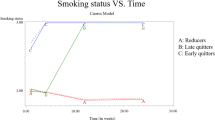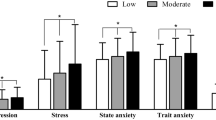Abstract
A valid measure of dependence on cigarettes is a useful tool for clinicians and researchers. The aim of this study was to develop a new, self-administered measure of cigarette dependence, and to assess its validity. The content of the instrument was generated in qualitative surveys. A long version (114 items) was tested on the internet in 3009 smokers. Subsamples provided retest data after 18 days (n=578), follow-up data after 45 days (n=990) and saliva cotinine (n=105). The study resulted in a 12-item scale labelled the Cigarette Dependence Scale (CDS-12), and in a 5-item version of this scale (CDS-5). Except for tolerance, CDS-12 covers the main components of DSM-IV and ICD-10 definitions of dependence: compulsion, withdrawal symptoms, loss of control, time allocation, neglect of other activities, and persistence despite harm. CDS-5 has similar measurement properties but less comprehensive content. Both scales had a high test–retest reliability (r⩾0.83), and a high internal consistency (Cronbach's α⩾0.84). CDS-12 scores were higher in daily smokers than in occasional smokers (+1.3SD units), and were associated with the strength of the urge to smoke during the last quit attempt (R2⩾0.25), and with saliva cotinine (R2⩾0.17). CDS-12 and CDS-5 scores decreased in daily smokers who switched to occasional smoking at 18-day retest. Dependence scores did not predict smoking abstinence at follow-up. In conclusion, CDS-12 and CDS-5 are reliable measures of cigarette dependence which fulfill several criteria of content validity and construct validity and are sensitive to change over time.
Similar content being viewed by others
Log in or create a free account to read this content
Gain free access to this article, as well as selected content from this journal and more on nature.com
or
References
American Psychiatric Association (1994). Diagnostic and Statistical Manual of Mental Disorders —Fourth Edition (DSM-IV). American Psychiatric Association: Washington DC.
Colby SM, Tiffany ST, Shiffman S, Niaura RS (2000). Measuring nicotine dependence among youth: a review of available approaches and instruments. Drug Alcohol Depend 59 (Suppl 1): S23–S39.
Covey LS, Elmer L (1999). The structure and validity of the DSM-IV criteria for nicotine dependence (Abstract). Nicotine Tobacco Res 1: 190.
Dawson-Saunders B, Trapp RG (1994). Basic and Clinical Biostatistics. Appleton & Lange: Norwalk, CT, p 165.
DiFranza JR, Savageau JA, Fletcher K, Ockene JK, Rigotti NA, McNeill AD et al (2002). Measuring the loss of autonomy over nicotine use in adolescents: the DANDY (Development and Assessment of Nicotine Dependence in Youths) study. Arch Pediatr Adolesc Med 56: 397–403.
Etter JF, Duc TV, Perneger TV (1999). Validity of the Fagerstrom test for nicotine dependence and of the Heaviness of Smoking Index among relatively light smokers. Addiction 94: 269–281.
Etter JF, Perneger TV (2001a). Attitudes toward nicotine replacement therapy in smokers and ex-smokers in the general public. Clin Pharmacol Ther 69: 175–183.
Etter JF, Perneger TV (2001b). Effectiveness of a computer-tailored smoking cessation program: a randomized trial. Arch Intern Med 161: 2596–2601.
Etter JF, Perneger TV (2001c). A comparison of cigarette smokers recruited through the Internet or by mail. Int J Epidemiol 30: 521–525.
Etter JF, Perneger TV, Ronchi A (1997). Distributions of smokers by stage: international comparison and association with smoking prevalence. Prev Med 26: 580–585.
Etter JF, Vu Duc T, Perneger TV (2000). Saliva cotinine levels in smokers and nonsmokers. Am J Epidemiol 151: 251–258.
Fagerström KO (1978). Measuring degree of physical dependence to tobacco smoking with reference to individualization of treatment. Addict Behav 3: 235–241.
Farkas AJ, Pierce JP, Zhu SH, Rosbrook B, Gilpin EA, Berry C (1996). Addiction versus stages of change models in predicting smoking cessation. Addiction 91: 1271–1280.
Feyerabend C, Russell MA (1990). A rapid gas–liquid chromatographic method for the determination of cotinine and nicotine in biological fluids. J Pharm Pharmacol 42: 450–452.
Fiore MC, Bailey WC, Cohen JJ (2000). Treating Tobacco Use and Dependence. Clinical Practice Guideline. US Department of Health and Human Services: Rockville, MD, USA.
Foulds J, Bryant A, Stapleton J, Jarvis MJ, Russell MA (1994). The stability of cotinine in unfrozen saliva mailed to the laboratory (letter). Am J Public Health 84: 1182–1183.
Greeley DA, Valois RF, Bernstein DA (1992). Stability of salivary cotinine sent through the U.S. mail for verification of smoking status. Addict Behav 17: 291–296.
Heatherton TF, Kozlowski LT, Frecker RC, Fagerstrom KO (1991). The Fagerstrom Test for Nicotine Dependence: a revision of the Fagerstrom Tolerance Questionnaire. Br J Addict 86: 1119–1127.
Horn JL (1965). A rationale and test for the number of factors in factor analysis. Psychometrika 30: 179–185.
Hughes JR, Hatsukami DK (1986). Signs and symptoms of tobacco withdrawal. Archi Gen Psychiatry 43: 289–294.
Hughes JR, Hatsukami DK (1992). The nicotine withdrawal syndrome: a brief review and update. Int J Smoking Cessation 1: 21–26.
Jackson DN (1970). A sequential system for personality scale development. In: Spielberger CD (ed). Current Topics in Clinical and Community Psychology. Vol. 2. Academy Press: New York, pp 61–96.
Johnson EO, Breslau N, Anthony JC (1996). The latent dimensionality of DIS/DSM-III-R nicotine dependence: exploratory analyses. Addiction 91: 583–588.
Kawakami N, Takatsuka N, Inaba S, Shimizu H (1999). Development of a screening questionnaire for tobacco/nicotine dependence according to ICD-10, DSM-III-R, and DSM-IV. Addict Behav 24: 155–166.
Kozlowski LT, Porter CQ, Orleans CT, Pope MA, Heatherton T (1994). Predicting smoking cessation with self-reported measures of nicotine dependence: FTQ, FTND, and HSI. Drug Alcohol Depend 34: 211–216.
Latimer WW, Winters KC, Stinchfield RD (1997). Screening for drug abuse among adolescents in clinical and correctional settings using the problem-oriented screening instrument for teenagers. Am J Drug Alcohol Abuse 23: 79–98.
Lichtenstein E, Mermelstein RJ (1986). Some methodological cautions in the use of the Tolerance questionnaire. Addict Behav 11: 439–442.
McNeill AD, Jarvis MJ, Stapleton JA, West RJ, Bryant A (1989). Nicotine intake in young smokers: longitudinal study of saliva cotinine concentrations. Am J Public Health 79: 172–175.
Moolchan ET, Radzius A, Epstein DH, Uhl G, Gorelick DA, Cadet JL et al (2002). The Fagerstrom Test for Nicotine Dependence and the Diagnostic Interview Schedule: do they diagnose the same smokers? Addict Behav 27: 101–113.
Nezelof S, Taccoen Y, Corcos M, Girardon N, Perez-Diaz F, Bizouard P et al (2001). Drug use in a declared non-addicted sample and comorbidity. A survey in 860 French-speaking subjects. Ann Med Intern 152: 18–25.
Nunnally JC, Bernstein IH (1994). Psychometric Theory. 3rd ed. McGraw-Hill: New York.
O'Connor BP (2000). SPSS and SAS programs for determining the number of components using parallel analysis and velicer's MAP test. Behav Res Methods Instrum Comput 32: 396–402.
Patten CA, Martin JE (1996). Measuring tobacco withdrawal: a review of self-report questionnaires. J Subst Abuse 8: 93–113.
Perez-Stable EJ, Benowitz NL, Marin G (1995). Is serum cotinine a better measure of cigarette smoking than self-report? Prev Med 24: 171–179.
Perkins KA, Gerlach D, Broge M, Grobe JE, Sanders M, Fonte C et al (2001). Dissociation of nicotine tolerance from tobacco dependence in humans. J Pharmacol Exp Ther 296: 849–856.
Pomerleau CS, Pomerleau OF, Majchrzak MJ, Kloska DD, Malakuti R (1990). Relationship between nicotine tolerance questionnaire scores and plasma cotinine. Addict Behav 15: 73–80.
Prochaska JO, DiClemente CC, Norcross JC (1992). In search of how people change. Applications to addictive behaviors. Am Psychol 47: 1102–1114.
Prokhorov AV, De Moor C, Pallonen UE, Hudmon KS, Koehly L, Hu S (2000). Validation of the modified Fagerstrom tolerance questionnaire with salivary cotinine among adolescents. Addict Behav 25: 429–433.
Sayette MA, Shiffman S, Tiffany ST, Niaura RS, Martin CS, Shadel WG (2000). The measurement of drug craving. Addiction 95 (Suppl 2): S189–S210.
Sciamanna CN, Hoch JS, Duke GC, Fogle MN, Ford DE (2000). Comparison of five measures of motivation to quit smoking among a sample of hospitalized smokers. J Gen Intern Med 15: 16–23.
Shadel WG, Shiffman S, Niaura R, Nichter M, Abrams DB (2000). Current models of nicotine dependence: what is known and what is needed to advance understanding of tobacco etiology among youth. Drug Alcohol Depend 59 (Suppl 1): S9–S22.
Shiffman SM, Jarvik ME (1976). Smoking withdrawal symptoms in two weeks of abstinence. Psychopharmacology (Berl) 50: 35–39.
Spak F, Hallstrom T (1996). Screening for alcohol dependence and abuse in women: description, validation, and psychometric properties of a new screening instrument, SWAG, in a population study. Alcohol Clin Exp Res 20: 723–731.
Streiner DL, Norman GR (1995). Health Measurement Scales A Practical Guide to their Development and Use. 2nd ed. Oxford University Press: Oxford.
Ustun B, Compton W, Mager D, Babor T, Baiyewu O, Chatterji S et al (1997). WHO Study on the reliability and validity of the alcohol and drug use disorder instruments: overview of methods and results. Drug Alcohol Depend 47: 161–169.
Velicer WF (1976). Determining the number of components from the matrix of partial correlations. Psychometrika 41: 321–337.
Welsch SK, Smith SS, Wetter DW, Jorenby DE, Fiore MC, Baker TB (1999). Development and validation of the Wisconsin Smoking Withdrawal Scale. Exp Clin Psychopharmacol 7: 354–361.
World Health Organization (1992). The ICD-10: Classification of Mental and Behavioural Disorders: Clinical Descriptions and Diagnostic Guidelines. World Health Organization: Geneva.
World Health Organization (1996). Guidelines for Controlling and Monitoring the Tobacco Epidemic. World Health Organization: Geneva.
Wright JG, Feinstein AR (1992). A comparative contrast of clinimetric and psychometric methods for constructing indexes and rating scales. J Clin Epidemiol 45: 1201–1218.
Acknowledgements
This study was supported by grants from the Swiss National Science Foundation to J-F Etter (3233-054994.98 and 3200-055141.98). Vincent Baujard, from the HON Foundation (www.hon.ch), developed the software for data collection.
Author information
Authors and Affiliations
Corresponding author
Additional information
Competing interests
JFE was reimbursed by Pharmacia Inc., a producer of nicotine replacement products, for attending international conferences, and was paid by Novartis to give lectures on smoking cessation. The Institute of Social and Preventive Medicine at the University of Geneva received financial support from Novartis to develop an education program for users of nicotine replacement products. JLH works with Pharmacia In.
Rights and permissions
About this article
Cite this article
Etter, JF., Le Houezec, J. & Perneger, T. A Self-Administered Questionnaire to Measure Dependence on Cigarettes: The Cigarette Dependence Scale. Neuropsychopharmacol 28, 359–370 (2003). https://doi.org/10.1038/sj.npp.1300030
Received:
Revised:
Accepted:
Published:
Issue date:
DOI: https://doi.org/10.1038/sj.npp.1300030
Keywords
This article is cited by
-
Cross-Addiction Risk Profile Associations with COVID-19 Anxiety: a Preliminary Exploratory Study
International Journal of Mental Health and Addiction (2024)
-
Differences in smoking behaviors and readiness to change for patients with COPD and differing categories of depressive symptoms: a descriptive cross-sectional design
BMC Pulmonary Medicine (2023)
-
Validation and Performance of the Brief Screener for Substance and Behavioural Addiction (SSBA) Amongst University Students
International Journal of Mental Health and Addiction (2023)
-
The Environmental Pollution and Cardiovascular Risk: The Role of Health Surveillance and Legislative Interventions in Cardiovascular Prevention
High Blood Pressure & Cardiovascular Prevention (2023)
-
Efficacy of approach bias modification as an add-on to smoking cessation treatment: study protocol for a randomized-controlled double-blind trial
Trials (2022)



